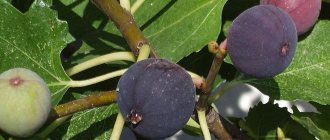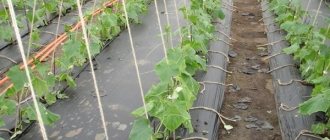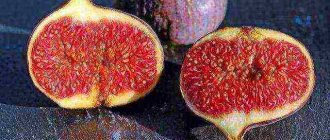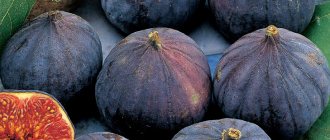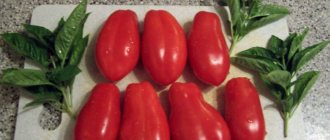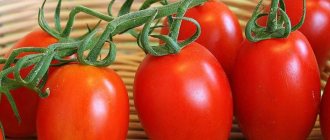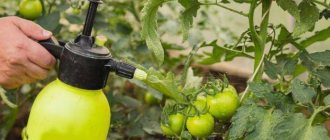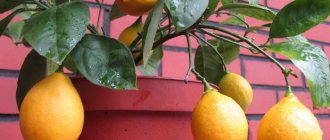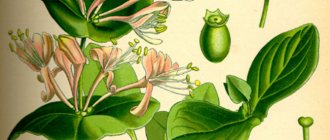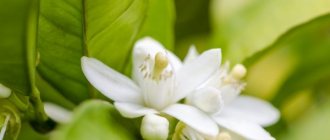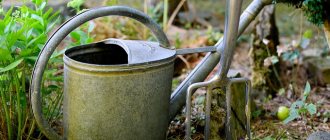Fig Brunswick
Height: 10-15 cm.
Brunswick (also known as: “Chapla”, “Transcaucasian Pink”, “Buzoy Burnu”) - The variety is self-fertile, two-yielding, medium tall. The leaves are five-lobed. The fruits of the first harvest are large (100-200 g), but there are not many of them, the flesh is pink. The second harvest is high, but the fruits are smaller in size and weight does not exceed 100 grams, with dark red pulp. The fruit is light green, with a purple blush, rounded pear-shaped. The variety in the central part of Ukraine has established itself as high-yielding, with fruits of good taste; formed in the form of a bush (5-10 vines) for the winter they are bent and pinned, then buried in a layer of soil (10-15 cm) without any additional insulation. The height of the bush is limited to two meters by annual pruning. Vines, which are already difficult to bend and bury at the 4-5th year of their life, are cut off at the root collar in the fall. Over the next growing season, replacement vines grow (1-1.5 m), and after overwintering they produce the first harvest.
Figs are heat-loving, not picky about soil and adapt well to dry room air. It is propagated by cuttings, root suckers and seeds. Figs planted from cuttings usually begin to bear fruit in the 2nd year. Sometimes shoots grow from the root; they can be separated and planted in separate pots, which are covered with a transparent plastic bag. Usually after 3-4 weeks the shoot takes root. Then the film is opened slightly for a while, accustoming the plant to the outside air. Gradually this period of time is increased.
It is better to replant figs before the growing season begins. Young plants are replanted annually, and 4-5 year old plants - as the root system grows. For mature trees, wooden boxes are usually made. Compared to citrus fruits, figs require a larger container, but before fruiting begins, they should not be planted in large pots - they will grow greatly, and the fruiting period will be delayed, and caring for large plants will become much more difficult. And when the plant begins to bear fruit, its growth will slow down.
With each transplant of young plants, the capacity is increased by approximately 1 liter. So, a 5-year-old fig bush requires a 5-7 liter container. Subsequently, with each transplant, its volume is increased by 2-2.5 liters. Figs are replanted using the transshipment method, although slight destruction of the earth clod, removal of old soil and replacing it with new soil are allowed. When replanting, prepare a soil mixture of turf soil, leaf humus, peat and sand in a ratio of 2:2:1:1; The pH of this mixture is 5-7.
Figs are a light- and moisture-loving plant, so during the growing season it is best to keep them in a bright room and water them abundantly. With a lack of moisture, leaves curl and then partially fall off; when the clod of earth dries out, the leaves may fall off completely, and although with abundant watering they will subsequently grow again, it is undesirable to allow this to happen. Under indoor conditions, figs bear fruit twice a year: the first time the fruits set in March and ripen in June, the second time - respectively, at the beginning of August and at the end of October. In the summer, it is advisable to take the plant out onto the loggia or into the garden.
At the beginning of November, figs shed their leaves and go into a dormant state. At this time, it is placed in a cool place (cellar, basement) or placed on a windowsill closer to the glass and fenced off from the warm room air with plastic film. Water it very rarely, not allowing the soil to dry out completely. The water temperature for irrigation should be no higher than 16-18°C, so that the buds do not start to grow. An option is to take the plant out onto the balcony before the first frost and leaves fall.
If in the fall the figs stand with green leaves, then a dormant period should be artificially induced: a deciduous crop needs rest, even if only slightly. To induce a dormant period, reduce watering and allow the soil to dry out slightly - then the leaves will begin to turn yellow and crumble. If the plant was in the room in winter, it begins to grow in December - early January, if in the basement or cellar - in February.
If necessary (if the fig grows only upward, without producing side shoots), the crown of the plant is formed by pinching the top of the central trunk. Later the side shoots are also pinched, and the long ones are shortened. This creates conditions for the growth of side shoots. Figs can also be planted in open ground, covering them well and pruning them heavily for the winter. There are many successful experiences in different parts of Ukraine.
For good development and fruiting, the plant is fed with organic and mineral fertilizers, but not during the dormant period. When the buds begin to bloom after winter rest, the plant is watered with infusion of manure (liquid biohumus), and after 10-15 days it is fed with liquid nitrogen-phosphorus fertilizer. You can use green manure fertilizers for watering; they contain a lot of nitrogen. (cut green grass is poured 1:2 with boiling water, left for 10-12 hours, filtered and watered.)
During the growing season, figs are regularly (2 times a month) fed with organic fertilizers (infusion of slurry (liquid biohumus), wood ash, infusion of herbs). To make the leaves have a bright green color, 2 times a year (in spring and summer) the plant is watered with a solution of iron sulfate (2 g per 1 liter of water) or the entire crown is sprayed with it. In spring and summer it is fed with microelements. For the prevention and treatment of diseases, which rarely happens in figs, the biological preparation “Mikosan” is used, and the biological preparation “Aktofit” is used for pests.
The best varieties of figs
Fig tree, fig, fig, fig tree, Smyrna or wineberry - all these names belong to one subtropical plant that loses its leaves in the winter, whose homeland is the Mediterranean and Asia Minor.
general information
Figs have been known to man since ancient times and have been cultivated for approximately five thousand years. Under favorable conditions, this tree grows and bears fruit for more than three centuries. The fruits, filled with juice and possessing excellent taste, were valued very dearly by gourmets. There are more than a thousand varieties of this magnificent plant. Fruits have different sizes, shapes, colors, tastes, ripening periods, and yields (some bear fruit twice a year). Fig berries are widely used in the food industry. A variety of figs has been developed that is used only for dried fruits and is not consumed fresh. The fig tree is indiscriminate in terms of growth conditions, bears fruit steadily, and is not susceptible to diseases and pests.
Figs: description, varieties, photos
The most popular ones include the following:
- Crimean black. It is of European origin. When caring for the crop, be sure to prune and shape the crown. Its high yield and mid-season fruit ripening make it possible to enjoy them twice a year - in July and September. The berries of the first harvest are large, purple, pear-shaped, asymmetrical in shape, the weight of which reaches 80 g. At the second harvest, the fruits are half the size, have an elongated pear-shaped shape and a black color, shimmering with violet. Raspberry juicy pulp has a slight sourness. In hot weather, the fruits of this fig variety are dried in the sun.
- Dalmatian. One of the best early ripening table varieties. Two harvests are harvested per year, the fruits of the first weighing 180 g, the second - 130 g. The shape is elongated, reminiscent of a narrow pear, the skin is yellowish with white spots. The reddish flesh is sweet with a slight sourness and melts in your mouth.
- Abkhazian purple. Refers to figs, the variety of which has a medium-late ripening period. Bears fruit generously twice a year. The first harvest ripens after mid-August, its fruits weigh no more than 80 g. The berries of the second harvest, weighing no more than 50 g, ripen in early November. The fruit is brownish-violet in color with an elongated, slightly ribbed shape and is very pleasant to the taste.
Frost-resistant
Figs, varieties of which can grow at temperatures down to -27 degrees, are grown in gardens and household plots as a decorative or fruit crop. Winter-hardy include:
- Brunswick. It is famous for its early ripening of very large fruits. Their weight reaches approximately 200 g. The shape of the berry is pear-shaped, the color is greenish with a purple tint. The juicy sugar pulp has wonderful taste qualities. Fruits twice a year. Multi-purpose application.
- Kadota. Medium-late ripening, harvested twice a year. The weight of the fruit of the first harvest is 70 g and 60 g of the second. The fruit is round in the shape of a pear, with a rather dense peel of a yellowish tint with a green tint. The rich, appetizing, pinkish-red flesh has an attractive taste. Figs of the Kadota variety are not damaged during transportation. Used in industrial and domestic conditions for the production of jams and preserves.
Self-fertile
Fig trees primarily have male and female flowers. Parthenocarpic are hybrid varieties whose fruits are formed without pollination. There are not many of them, and one of them includes the White Adriatic fig. Description of the variety: fruits weighing up to 60 g with greenish skin and reddish flesh. They ripen twice a year. The berries have a pleasant sugary, almost no sour taste.
Large-fruited
They have advantages over others due to their large and tasty fruits. The largest fruits include:
- San Pedro is black. It was bred in Spain and gained its popularity all over the world; the fruits are shaped like a beveled egg up to 10 cm in diameter, pleasant to the taste. The berries grow on vigorous fig trees that require care and good fertile soil. Under ideal conditions, the fig tree produces a rich harvest twice a year. The fruits have aromatic, sweet pink flesh and almost black skin. Consumed fresh, dried or processed.
- Corderia. The berries of this variety of figs (photo below) are large, covered with a yellowish-green skin and contain orange, very sweet pulp of excellent taste. Corderia perfectly withstands moisture deficiency in the soil, so it is preferred to grow it in waterless areas.
- Sugar Celeste. Frost-resistant variety with large berries and two harvests per season. The fruit is sweet and juicy, pear-shaped with a thin greenish skin with a purple tint.
Strawberry. The variety is distinguished by tall, strong trees and good cold resistance. Plants have good productivity. Their pear-shaped fruits with a refined taste, sweet, fragrant medium-sized pulp ripen after August 15. Used in fresh and processed form.
Honey. Mid-season, does not require pollination, the trees are heat-loving, low-growing, spreading, do not need highly fertile soils. The fruits are light green in color and unusually sweet. The tree is suitable for growing at home.
Brogiotto nero. The pear-shaped fruits grow on tall, strong trees that produce two consistently high harvests per season. The berries weighing up to 90 g have a burgundy-colored skin and excellent taste. And also the best early ripening varieties include Dalmatian and Brunswick figs, the description of which was made above. It takes 80 days for them to fully ripen.
Mid-late varieties
Temri. It grows in the Caucasus, and its homeland is Tunisia. The plant is self-fertile, very productive, the fruits begin to ripen at the end of August, fruiting ends in November. The berries are sweet, ovoid, slightly ribbed, covered with burgundy-purple skin, weighing up to 75 g.
Date Neapolitan. It bears fruit once a season in September. The fruits are pear-shaped, medium in size and have good taste, the pulp is raspberry-colored, the skin is burgundy with a purple tint.
Pink fig tree
The fig variety Sabrucia rosea bears fruit without pollination, is a winter-hardy tree, can withstand frosts down to -18 degrees, and produces two harvests per season. The first is called winter because the ovary forms in the fall and, with good shelter, is perfectly preserved until the spring warmth. In July these fruits ripen. And at the very beginning of June, in place of the new growth, a second harvest is formed, the fruits of which ripen in September.
Large berries with a diameter of 5 to 6 cm and a length of up to 10 cm have a pear shape and excellent taste. The skin is grayish-pink in color, and the flesh is the color of strawberries. A fully ripened fig fruit is sweet and aromatic. The tree should be grown in trenches and covered with insulation for the winter in order to obtain a July harvest. For the autumn harvest, it is enough to cover the base with soil, pull it together and wrap the tree with material. Berries picked after drying have a rich aroma and are very sweet, while berries picked after yellowing of the peel are less fragrant and of moderate sweetness, but are stored longer.
Figs: description and reviews
Varieties that are relatively resistant to frost include:
- Sochi 7. Good yield, fruit weight reaches 50 g, the berries have a pleasant, slightly sour taste.
- Nikitsky. The plant is partially self-fertile, mid-ripening, the fruits are sweet and sour, large.
- Dalmatian. One of the best table varieties (description above).
The most problems arise when growing figs in winter. The main task is to preserve the trees and prevent them from freezing, so amateur gardeners most often share their experience in preparing frost-resistant fig varieties for winter. In their reviews they recommend:
- plant the plant in places protected from the wind and form it correctly;
- before the onset of winter, the soil in the root part of the plant should be dry, and the roots themselves should be moist;
- Make the shelter breathable so that fungal diseases do not appear, and during thaws there is ventilation.
Conclusion
According to archaeological data, figs are one of the first crops that people began to cultivate for food. This happened a thousand years earlier than the appearance of cultivated cereal plants. Surprisingly, the Pink Fig variety is a tomato. The name was not chosen by chance. Tomatoes are very similar in appearance and taste to figs. In our country, fig trees are grown in the Crimea and Krasnodar Territory. In warm climates, growing fig trees is not difficult, but where the weather is cool, the harvest is obtained in greenhouses or at home on windowsills, using only self-fertile varieties.
For many centuries, the fig tree was considered a symbol of prosperity, peace and eternal life. More than a thousand varieties of this culture are known. They differ in the taste of the fruit, their shape and yield, frost and drought resistance characteristics, and requirements for agricultural technology. Let's consider those varieties of figs that are most popular among amateur gardeners.
White Adriatic is considered self-fertile and does not require additional pollination
This variety is common in many countries. It gained popularity thanks to the Nikitsky Garden, which intensively cultivated it from the 30s to the 60s. He also distributed seedlings and donated them to various scientific institutions. It is also known as Sochi. Well suited for growing in open ground using advanced technologies.
White Adriatic is considered self-fertile and does not require additional pollination, but with its presence the quality and quantity of fruits increases. Fruiting - 2 times a year. The fruits are small, up to 60g, oval in shape with a flat top. The flesh is pink, very sweet, the skin of the fruit is yellow-green.
Video about figs
A feature of this variety is resistance to gray rot, good preservation for a long time, and all this is due to the thick skin.
Dalmatian is the best variety for table use
Variety Dalmatian or Turkish white. It is one of the best early ripening table varieties. It is self-fertile and bears fruit twice a season. Its peculiarity is that at the first harvest the fruits reach a very large size - up to 180g. The trees produce a rich harvest after three years.
The plant can easily withstand temperatures ranging from 0 to -15 C. Therefore, Dalmatian figs can be called frost-resistant. The fruits are pear-shaped, the skin is gray-green, the flesh is reddish, juicy, sweet with a slight sourness. In terms of taste, it is considered the best.
Did you know that among all dried fruits the first place in fiber content belongs to figs? Therefore, it is recommended for use to normalize the functioning of the gastrointestinal tract. In addition, this unique fruit contains a lot of potassium, which is good for hearts. And the rich enzyme composition allows you to normalize the functioning of the liver, stomach and kidneys. In terms of iron and calcium content, amazing figs are also significantly superior to other fruits and are recommended for nutrition in case of iron deficiency anemia and for patients during the recovery period after operations and injuries.
The plant can withstand temperatures ranging from 0 to -15 C
Kadota figs are good for preparations
This self-pollinating variety has gained particular popularity in California. Later it spread to many countries around the world. Refers to self-fertile and early-fertile varieties. The fruits reach a weight of 60g. The shape of the fruit is pear-shaped, slightly rounded, light green in color. The fruit pulp is bright pink, juicy, sweet. The variety is easily transported over long distances.
The fruits tend to wilt directly on the tree and are good for jam, jam and drying.
Did you know that regular consumption of figs paralyzes the proliferation of cancer cells and promotes retinal regeneration? But it is not recommended for diabetics, patients with metabolic disorders and obesity, because the fruit has a high sugar content.
Crimean black - unpretentious and high-yielding
Scientists at the Nikitsky Botanical Garden distinguish the variety from other specimens by its European origin. Refers to early-fertile and self-fertile varieties. Crimean black figs produce crops twice a year. When caring for trees, it is recommended to pay special attention to pruning and crown formation. The variety responds well to this procedure and produces a high yield every year.
When caring for trees, it is recommended to pay special attention to pruning and crown formation
The ripening time is extended. The fruits of the first harvest are medium-sized round figs. The second harvest is characterized by smaller black fruits with a purple tint. The taste of the fruit is sour, which makes the variety unique and in demand. Great for making jam and drying. Crimean black is perfect for planting in open ground covering structures.
Brunswick figs are the most frost-resistant
This variety is also called Chapla or Buzoi Burnu. Refers to self-fertile. The first harvest produces a small number of fruits. But they are large, reaching two hundred grams. The second harvest pleases with a large number of smaller figs. The fruits are light green in color with a raspberry core. The variety has proven itself to have excellent taste and frost resistance down to -28°C.
Video about Crimean black figs
Sometimes in markets and fruit shops you may be offered to buy royal figs. There is no variety as such in the register. Most often, this is the name for large-sized fruits with a dark blue or purple peel color. This name is not evidence of the variety, but an indicator of quality.
Figs are one of the most ancient fruit crops on Earth, and in our latitudes they are more often found in winter gardens or grown as a houseplant. Many gardeners are stopped by the fact that the tree needs winter shelter, as it does not tolerate frost. But, after studying the descriptions and choosing the optimal frost-resistant fig varieties for yourself, taking care of the correct agricultural technology and protecting the plant from the cold, you will forever remain a fan of this culture.
Figs are one of the oldest fruit crops grown by humans. Its fruits, called figs, wineberries, or figs, are used in the food industry in many countries. Today, more than 1000 varieties of this plant are known. They differ in size, color, taste of the fruit, ripening time, and the number of harvests per year. Some varieties of fig trees require pollination. There are hybrids that are bred exclusively for growing dried fruits; their fruits are not used fresh.
Before purchasing seedlings of this crop, you need to study the description of the fig variety and make sure how suitable it is for the climatic features of the area where it will be grown. An important factor when choosing will be the purpose of growing a fig tree, since there are varieties used for processing and those whose fruits are consumed raw.
Any variety is suitable for drying. In some species of this plant, the fruits ripen first at the top and then closer to the base of the fruit.
A seedling grown from a seed will begin to bear fruit in 7-10 years. Grafted trees begin to bear fruit in 3-4 years. You can distinguish between grafted figs and those grown from seed by the root system of the plant. Thus, seedlings grown from seed have a weak root system, and the trunk and branches are quite thin. Grafted individuals have a thick trunk at the base and a strong root system.
The most common varieties of figs:
| Crimean black | Kalimirna | Commune |
| Dalmatian | Sochinsky – 4 | Kadota |
| Brunswick | Corderia | Smirnensky |
| Abkhazian purple | July | Violet |
| Randino | Gray early |
dacha-posadka.ru
Brunswick
Imported in 1901 from Georgia (Tbilisi Botanical Garden) under the names Chapla, Transcaucasian pink, Nero bianco, D'or. In the same year, it was received from Batumi (Adjarian Autonomous Soviet Socialist Republic) under the name Die Risnin and from Orleans (France) under the names Madeleine, Precoce de Barcelone, Violette delicatissima, Brojiotto. In 1927 it was imported into the Garden from Alunka (Crimea) under the name Bal Fig, Crimean 95, in 1929 - from California under the name Brunswick, in 1932 - from Germany as Gelbfeige and Feige de Schlosse Kennedy; in 1935 from Israel as Khurtmani, in 1934 from Texas and in 1935 from Marrakech (Morocco) under the name Brunswick.
It has many synonyms: Magnolia, Black Naples, Brown Hamburg, Hanover, Madonna, Clementine, Buzoi burnu, etc. Under the name Clementine, this variety was imported into the Garden from France back in 1821, propagated and transferred from the nursery to private individuals on the South Coast Crimea, where it received the name Bal Fig (in Tatar). Found in the Azerbaijan SSR. It was first described in 1755 by Duhamel. Descriptions of this variety are also available in Eisen (1901), Starnes and Monroy (1907), and Condit (1947, 1955). In domestic works it was given by Arendt (1939, 1949), Chernenko (1940), Nesterenko and Strebkova (1949), Fedorov (1950), Leontyeva and Manuylo (1961). In 1949, it was transferred to state variety testing at 8 state variety sites in the Krasnodar Territory, Georgian, Azerbaijan and Turkmen SSR. In 1953 it was zoned under the name Brunswick. It produces two harvests, the first being small. The number of second generation fruits in Crimea on trees aged 8-10 years reaches 800-1000. It can bear fruit without pollination, but in conditions of low soil moisture, pollination is necessary to preserve the crop. The fruits of the first generation ripen in early July, the second - in late August - early September. Ripening lasts for 25-35 days. Trees of moderate vigor, with spreading branches. The crown is flat-rounded, not very dense, slightly drooping. Annual shoots are medium-sized, of medium thickness (1.1-1.2 cm), light brown, slightly pubescent when young, with rare bright lenticels on the nodes. The apical buds are small, narrow, strongly pointed, greenish-yellowish. The inflorescences are asymmetrical, elongated pear-shaped, without necks, often widened at the base, slightly ribbed, semi-matte. The pedicels are short, (0.2-0.3 cm), thick. The eye is convex, greenish-pink. The spots on the skin are small (thick) and large (sparse). The leaves are medium in size, on long petioles, semi-rolled, five-lobed, cut to 3/5 of the length. The bases of the veins are fused over a length of 1.5-2 cm. The leaf blades are hard on top, with convex veins and bright white stiff hairs on a dark green background; below - light green, slightly pubescent. The middle lobe is often notched and has 2-3 large lobes. The notches between the lobes are round, wide (1-2 cm), diverging. The bases of the leaves are truncated or slightly wedge-shaped, the edges are toothed and crenate. The fruits of the first generation are 7.5x5 cm in size, weighing 80-100 g, sessile, asymmetrical, with convex bases and flat tops. The main color of the skin is light green, the outer color is light brown on the illuminated side, turning into violet-red. The eyes are small, pink-red, open. The fetal leg is thick, fleshy, widened towards the base of the fruit. The skin is tender, longitudinally cracking, slightly pubescent, matte, with very dense small yellow spots. The fruit is creamy; the flesh is pink, finely layered, with a fairly large cavity, sweet, pleasant, very juicy. The fruits of the second generation are 5.8X4.8 cm in size, weighing 50-60 grams or more, rounded pear-shaped, cube-shaped, asymmetrical, slightly ribbed, sessile on short stalks (0.4-0.6 cm). The skin is thin, tender, light green at the stalk and yellowish at the eye, with a brownish-red blush almost throughout the fruit. The spots are clearly visible, yellow, large. The pubescence of the skin is average. The waxy coating is noticeable. The eye is open, slightly raised, medium size, pink. The fruit is wide, creamy; the pulp is tender, juicy, brownish-red, highly sugary, with weak acidity. The cavity is small, the seeds are small.
Suitable for fresh fruit use.
Description of Brunswick figs
In the subtropics, the tree grows over 2 m, the flat-rounded crown is created by spreading branches. The roots of figs are just as branched, sometimes more than 10 m in diameter and 5-7 m deep. In the Russian climate, even in the south, Brunswick figs are not allowed to reach such a height by regularly pruning the branches, and when planting, care is taken to prevent the long spread of roots. The leaves are sharply different from any known crop: very large, up to 20-25 cm, with deeply cut lobes. Dense and rough on top, fleecy and soft below. Flowers of the female type are also unusual, inconspicuous, located inside the future fruit formation, which grows in the form of an irregular, elongated ball.
Early self-fertile Brunswick fig gives 2 full harvests if there is sufficient heat:
- in midsummer;
- at the beginning of autumn.
The Brunswick variety ripens within 2.5-3 months. The fruits reach technical ripeness 25-60 days after harvest.
In mid-summer, the first wave of ripe Brunswick figs is quite sparse. The fruits are large, with a flat top, measuring 5x7 cm, weighing up to 100 g or more. The outer skin color is often purple. There is a large cavity in the pink juicy pulp. The taste is sweet and pleasant. Autumn fig fruits are irregularly pear-shaped, small - 5x4 cm, do not exceed 70 g, and may not ripen in the middle zone climate due to early frosts. The thin, fleecy skin is light green and turns yellow-brown in the sun. The fruits of the second harvest have tender, reddish-brown flesh with a high sugar content and a small cavity. The seeds are small and common.
Forum statistics
207036 Messages in 1634 Topics from 5593 Users. Last user: Amaya Last message: “Let's talk about the weather in Vash...” ( Today at 07:52:22 ) Latest messages on the forum.
Now on the forum
53 Guests, 11 Users
Users in the last 15 minutes: DIL, Mikhail77, Lyuda5, Belgorodets, Tatyana Provorova, Eduard., ElenkaF, Elena Z, Soshnin Yura, Grinya, Vlad51 [Blocked] [Section Moderator] [Forum Moderator]
Maximum online today: 100 . All-time maximum online: 2758 (28 July 2021, 17:22:51)
Users who visited the forum in the last 24 hours
Total: 292
(Visible: 291, Hidden: 1) 1963, DIL, Mikhail77, Lyuda5, Belgorodets, Tatyana Provorova, Eduard., ElenkaF, Elena Z, soshnin yura, Grinya, vlad51, pioneer-2, Ivan Levin, y_fed, Natasha, Taker, freesia, Mst, marlin64, VeraNiK, gardener, Filippov Oleg, Kenig, Marina Protasova, Nikolay 2, Vasily 53, rambo, ALEX, 77volt, Elvira2017, kvg, Evgeniy52, sergei, Ser, Evgeniy 163, Lyubov S., Erem, polyanina Ekaterina, kosmos, Yura, GALINA ANOKHINA, DorontsovPeter, ZaycevAS, Alex65, 64nikolay64, Vova Kapran, zsb, Polina77, spotlight, Mikhail Alekseevich, Svetla777, Quiet, Marshal, Nikolay S., therapist, Liza, Capricorn, lomakin1969, Alexander Vl. , Andrey76, Slavka, Tatyana B, Cherkessk, Eugene, leonidych, vladimirM, yotmast, mers, Serg1707, SNovichek, hanter64, znakomij, Alexander K, Vardan, Sergey Fer, Anatoly Sivkov, Alexey V, Ilya 77, Andrey Gladilin, Tatyana A ., in Astrakhan, Oksana Kopp, sem_en, Vladimir 153, skier, Igor Viktorovich, slavalimon, Primorets, OlgaOs, SANYCH, 31rus, mystic69, Andrey Tsvetkov, Buba, igor222, Nikolay Rex, Sergey 1965, Vladimir Buturlakin, DSW, psv1960, Dmitry 77, Vasily V., Vyacheslav03, Natalia Nikolaevna, Sergey Tashchiyan, Igor Sergeevich, alexsandr, Pioneer, nicson7, Elena Aleshchenko, Alexander-ask-34, Verona, Igor F., Henry, Yuri72, L.A.P., Gaivoronsky Yuri, Sergeevich, Sergey Chistokletov, Svetlana Streletskaya, Galinka, Alexey Deminov, Naumov Igor, Vyacheslav136, Gloomy, Katrin, AndSanych, Mikhno Alexander, Ded31, Vladimir ++, Lydia58, ALEXANDER BRYANSKY, Vladimir-kanevskaya, Amber7394, TITOVA LOVE, Linx, alexander66, Natalia M, Mikhail Fesenko, Amaya, Alexander71, Boris 1952, tsv, Maximilian, 25nata35, nadia, Igor_K, Alexander Kolesnikov, Pitko, weather forecaster, eSAa, cecet71, atseton, Alexander Smirnov, Vladimir Kostochkin, Vladimir Berdnikov, Gocha , LeXa_KoT, Sergey 61, Sergey Yuryev, alexss, Skif, Vladimir Kovba, dayton, Yuri Semenov, N.A. Sokolov, Pavlentiy, Sa-shura, Volgogradka, Dmitry Anatolyevich, Grandfather Igor, Andrey Lis, Bublichenko Alexander M, Marina Krymskaya STENLLY2010, Irahelm, Vyacheslav Vladimirovich, Vladimir Shilov, Aprel, Badaev Dmitry, Gheo55, Berry, Valentina Ivanovna, Kryn, Oleg9f, DED2, Korotina Svetlana, brought Oleg Ivanovich, Santra, L2K2M7N, Alexander48, VIKNIK, Andrey, Andrey, M2D, VALEA Riy Rastorguev, Gardener - amateur, Galina, Vasily1111, Salex, Sergey Ko, Ramiz, Victor_, potap05, Yuri 36, VitalySD, Inna161, Vladimir Shcherbinin, Valerie, niy1, cfibr, Andrey68, kulol3, thanatos, Serzh1978, Realist, Artur53, max2008 -01, LOZA, AlexanderD, Grandfather Young, Zayac, ketch, Rita, alx-74, Iv Iv, Alexander150, Igor K, Vasily Viktorovich, kdm57, Veniaminovich, Boris Sokolyansky, , vikbublik, neposny, Evgen, Victoria Aleksandrovna, Serezha 64 , Wintel, Airbone, teri, Sergey Lomonosov, Khramov, serginio, Leonty Yarygin, Irina O., Nadezhda Grig, netolya, Saisan, Agryzkov Alexey, Vadi, Zinaida, Vadim, Alexander Taganrog, Sukhonos Sergey, Snezhinets, evgen_26, nau_63, Masha_gardener , Gennady163, krasnovlad1, Alexander Zinoviev, Roman Fedorovich, TIS, Alexey Sergeevich, arnyusha, Zheka, Nurtas, kradievska, nick041, Valentina Medvedeva, Sergey43, Andrey S., Nikolay Lipunov, Vertuoz2, Vladimir VS, NatalyaMed, Kinna, Mikhail Michurinsk, alekcsan1, VALERY TAMB, Sasha57, MikhAf, Y_Azer, Andrey Beribesov, hunter1955, nut lover, Keys, Ivan Shmelev, Pestle, anton_slash
Frost resistance of Brunswick figs
According to the description, when grown in open ground, Brunswick figs can withstand frosts down to -27 °C when covered. However, in reviews, many gardeners indicate that prolonged low temperatures below - 20 ° C lead to freezing of the plant. The Brunswick variety has the ability to recover after a harsh winter and send out new shoots from the root system preserved under shelter. The main task of the gardener is to keep the roots from freezing. This is achieved by specific methods of shelter. The crop is grown in greenhouses or indoor conditions, planted in tubs in those zones of frost resistance of plants where the maximum minus values fall below the level of 18-12 ° C.
Tips for growing figs in the Moscow region
2013-04-04
Ficus carica, or fig tree, is an inhabitant of the subtropics. It is a deciduous shrub or tree up to 12 m high. In the subtropics it is pollinated by blastophages - small nut-bearing wasps that are not found here. Therefore, in our region, self-fertile (parthenocarpic) varieties are grown in apartments, winter gardens and greenhouses. There are many of them bred, for example, Dalmatian, Nikitsky, Abkhazian purple, Crimean black, Kadota, Brunsvik, Shuisky, Gray early, Sary Apsheronsky, Adriatic purple, Sochi No. 7, Randino, Pomorie, July, Lardaro, Gift to the 50th anniversary of October, Brown Turkey.
The best varieties of figs
Dalmatian
Tolerates temperatures down to -15 °C. It bears fruit well when it has built up a long-term supply of wood. The best harvest is produced by three- and four-year-old shoots. The fruits of this variety are pear-shaped, asymmetrical, yellow-brown or greenish-yellow in color. The weight of an average fruit is 150-200 g. In terms of taste, it is the best of the figs I grow.
Nikitsky
Ribbed figs are pear-shaped, light brown in color, weighing up to 120 g.
Kadota
The fig fruits of this variety are pear-shaped, ribbed, greenish-yellow or yellow-brown in color. They weigh about 100 g.
Brown Turkey
It is considered one of the most winter-hardy varieties, withstands short-term temperature drops down to -20 ° C. Very productive. Brown Turkey fruits are regular pear-shaped, red-brown in color, weighing up to 100 g.
Crimean black (Mouissoune, Negron)
Oval ribbed fruits. Purple-blue, almost black. They weigh about 100 g.
Gift for the 50th anniversary of October
Outwardly, it is very similar to the Kadota variety, but surpasses it in yield.
Sochi No. 7
Pear-shaped fruits are yellow in color with a matte coating, weighing up to 60 g.
Brunswick (Chapla)
The fruits are pear-shaped, asymmetrical, light green or light brown, violet-red on the sunny side, weighing up to 100 g.
The impossible is possible
Unfortunately, there are no varieties of figs that could withstand thirty-degree frosts near Moscow without shelter. Therefore, in our region it is usually grown in an apartment, in a winter garden, in a greenhouse or in a greenhouse. In the spring, the plant is buried in the garden directly with the pot, and in the fall it is dug up and brought into a frost-free basement for the winter; Figs overwinter normally in the house, and then actively set fruit. The temperature in the basement should not fall below - 5 °C: the pot will freeze, and the root system of the fig is more vulnerable than the above-ground part.
[ad#ad-1]
I grew figs both in greenhouses and in containers, but at some point I began to leave them to overwinter in open ground. Some gardeners bend the figs into a trench, place a wooden shield or slate sheet on top and cover it with earth. I don’t really like this method: our winters are damp, the risk of wood dampening increases, and this is not good for the plant. For wintering, I make a rectangular box from expanded polystyrene or polystyrene foam 1 m long, about half a meter wide and high, the thickness of the walls should be at least 10 cm (you can glue two sheets 5 cm thick together). I wrap the box with tape several times. I usually put something heavy on top, for example, an old window frame, so that it does not get blown away by the wind and crush the roof with snow.
In winter, I additionally cover the structure with snow. In May, when the threat of frost has passed, you can completely remove the shelter. But I would suggest not disassembling it at all, but instead of the top cover in April, put a sheet of cellular polycarbonate or simply stretch plastic film, building a mini-greenhouse. You just need to leave a small gap for ventilation to avoid overheating. Figs begin to vegetate at an average daily temperature of +7...+9 °C, the optimal temperature for fruit ripening is +20...+35 °C.
Growing conditions
Figs will bear fruit if planted in a well-lit place, protected from northern and eastern winds. It is best near the south wall of the house. Depending on the variety, it can tolerate temperatures down to -10...-20 °C. Thanks to its powerful root system, even when completely frozen to the ground, it is easily restored from the root. Figs are drought-resistant, but with a lack of moisture, the yield decreases. However, in the conditions of the Moscow region, natural humidity is enough for it. Prefers light and medium loams, but soil richer in organic matter will have a beneficial effect on fruiting. It is best to plant in a small trench 30-40 cm deep at an angle of 45 degrees, so that in October, when the figs shed their leaves, it is easier to bend the branches to the ground. However, it is undesirable for them to touch the ground. Some of the thickening annual shoots can be removed.
Figs grow quickly, so you need to pinch the shoots in a timely manner. On young plants, 3-4 developed branches are left, the rest are removed. I try not to let them grow more than 40-50 cm. This way the figs will not outgrow the size of the shelter. During the growing season, it is recommended to liberally apply liquid fertilizer based on manure every three weeks until the beginning of August; in August, feed with infusion of ash (infuse 1 liter of ash per 10 liters of water for 3-4 days).
Experience in planting figs in open ground shows that there are no pests on the plant. Parthenocarpic varieties are propagated by cuttings, which can be easily rooted in sand or light soil consisting of 50% sand and 50% peat (or turf soil).
Discuss the article on the forum
osadovod.ru
Pros and cons of the Brunswick fig variety
The fruits of this southern crop are so excellent in taste that gardeners dream of new breeding achievements. Perhaps somewhere they are already working on developing more frost-resistant varieties of figs. For most gardeners in the middle zone, the impossibility of wintering the plant in open ground is the only drawback of the Brunswick variety. Although it is still the most cold-resistant of its species.
Advantages of the Brunswick variety:
- figs are adapted for growing in climates where in winter subzero temperatures briefly drop to -20 °C;
- high productivity;
- excellent taste;
- self-fertility;
- early ripeness;
- possibility of collecting sweet fruits twice a day.
Growing Brunswick Figs
Remontant Brunswick figs with light green fruits are planted taking into account the specific requirements for caring for the southern crop.
Selection and preparation of a landing site
Figs are unpretentious to soils: they can grow well on sandy, loamy, clayey and calcareous soils. But the taste of the fruit depends on the amount of minerals in the planting hole and on the site. High acidity of the soil is not suitable for the crop. One of the important requirements for successfully growing figs is a sufficient amount of moisture and at the same time good drainage of the soil. In the middle zone, for the Brunswick variety, it is better to dig a trench in advance along with a hole where the plant is placed for winter shelter. For the planting substrate, garden soil is mixed with an equal part of humus or compost and half of the sand is added. The landing site should only be on the south side, protected by buildings on the north.
Perlite is added to the substrate in the tubs, and a drainage layer is also provided. Indoor plants of the variety are replanted after 2-3 years, constantly cutting off the roots during transfer.
Landing rules
When planting the Brunswick variety, the following requirements are met:
- the planting pit should be 2 times the volume of the container from the nursery;
- when planting figs, the stem is placed deeper in the soil than it grew in the container;
- near the trunk, retreating 20-30 cm, hammer in a support;
- straighten the roots, sprinkle with the remaining substrate, simultaneously compacting it several times;
- water with 10 liters of water, every other day moisten it again with this amount and mulch the hole.
Watering and fertilizing
Brunswick figs are irrigated moderately, taking into account the age of the plant:
- in the first 2-3 years, water every 7 days, a bucket per tree;
- adult specimens - once every 2 weeks, 10-12 liters;
- During the fruit ripeness phase, watering is not carried out;
- The last watering is applied after harvesting the fruits in September.
The culture is fed after 15 days:
- Nitrogen preparations are used in spring;
- during flowering - complex, with phosphorus;
- Potassium compounds are added in the phase of enlargement of the ovaries.
It is convenient to carry out foliar feeding with ready-made balanced products. A good fertilizer for figs is organic matter. A prerequisite for fertilizing is application with watering for better absorption of nutrients.
Trimming
Brunswick figs, judging by the description of the variety and photos, in the southern regions form a spreading cup-shaped crown, with a stem height of 40-60 cm. In the middle zone there is a two-meter bush, which is easier to bend to the ground for shelter in winter. In spring, shoots that thicken the crown are removed. Fan pruning is also practiced, when all the branches that grow vertically are cut off from a three-year-old seedling. The lower shoots are bent using available means after the tree has been watered. Branches older than 5 years are cut off at ground level in the fall, because they no longer bend over when covering. New shoots of the Brunswick variety begin to bear fruit within a year.
Preparing for winter
In the gardens of the middle climate zone, the vines of the Brunswick fig, formed by a bush, are bent down and dug into pre-prepared trenches. The branches are bent gradually, starting from the day the last fruits are removed. In regions with mild winters, the entire tree is wrapped after the onset of frost. The tree trunk circle is mulched with sawdust, peat or spruce branches. In Crimea, the Brunswick variety is grown without winter shelter.
Figs: description, varieties, photos
The most popular ones include the following:
- Crimean black. It is of European origin. When caring for the crop, be sure to prune and shape the crown. Its high yield and mid-season fruit ripening make it possible to enjoy them twice a year - in July and September. The berries of the first harvest are large, purple, pear-shaped, asymmetrical in shape, weighing up to 80 g.
At the second harvest, the fruits are half the size, have an elongated pear-shaped shape and are black in color, tinged with violet. Raspberry juicy pulp has a slight sourness. In hot weather, the fruits of this fig variety are dried in the sun.
- Dalmatian. One of the best early ripening table varieties. Two harvests are harvested per year, the fruits of the first weighing 180 g, the second - 130 g. The shape is elongated, reminiscent of a narrow pear, the skin is yellowish with white spots. The reddish flesh is sweet with a slight sourness and melts in your mouth.
- Abkhazian purple. Refers to figs, the variety of which has a medium-late ripening period. Bears fruit generously twice a year. The first harvest ripens after mid-August, its fruits weigh no more than 80 g. The berries of the second harvest, weighing no more than 50 g, ripen in early November. The fruit is brownish-violet in color with an elongated, slightly ribbed shape and is very pleasant to the taste.
Diseases and pests
Figs are threatened by the fungal disease fusarium, which first affects the roots and lower part of the trunk. Then the plant dies. Affected specimens are removed from the area. The crop is parasitized by aphids, moths, and psyllids, which destroy leaves, damage fruits, and transmit pathogens of fungal and viral diseases. The proliferation of pests and the spread of diseases is prevented by autumn harvesting of leaves and spraying of the buds with copper-containing preparations, treatment with fungicides, and insecticides.
